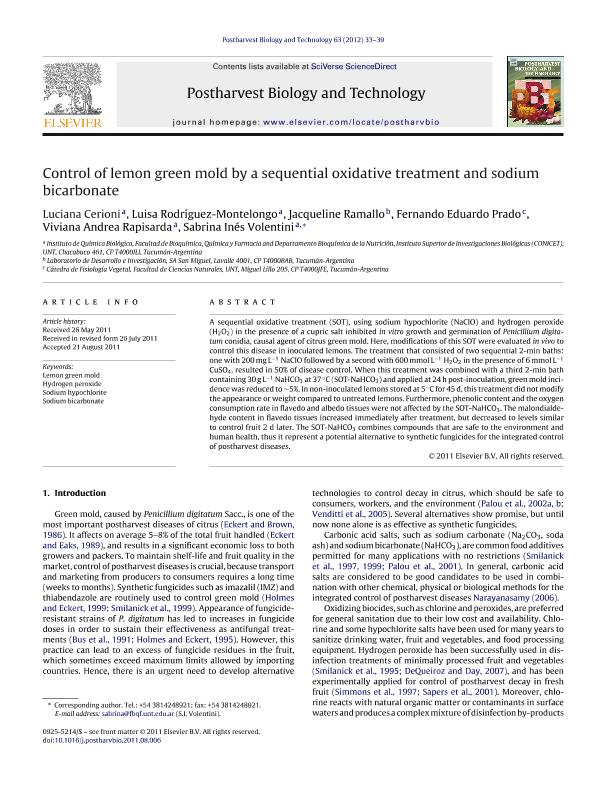Artículo
Control of lemon green mold by a sequential oxidative treatment and sodium bicarbonate
Cerioni, Luciana ; Rodriguez Montelogo, Luisa; Ramallo, Jaqueline; Prado, Fernando Eduardo
; Rodriguez Montelogo, Luisa; Ramallo, Jaqueline; Prado, Fernando Eduardo ; Rapisarda, Viviana Andrea
; Rapisarda, Viviana Andrea ; Volentini, Sabrina Inès
; Volentini, Sabrina Inès
 ; Rodriguez Montelogo, Luisa; Ramallo, Jaqueline; Prado, Fernando Eduardo
; Rodriguez Montelogo, Luisa; Ramallo, Jaqueline; Prado, Fernando Eduardo ; Rapisarda, Viviana Andrea
; Rapisarda, Viviana Andrea ; Volentini, Sabrina Inès
; Volentini, Sabrina Inès
Fecha de publicación:
01/2012
Editorial:
Elsevier Science
Revista:
Postharvest Biology and Technology
ISSN:
0925-5214
Idioma:
Inglés
Tipo de recurso:
Artículo publicado
Clasificación temática:
Resumen
A sequential oxidative treatment (SOT), using sodium hypochlorite (NaClO) and hydrogen peroxide (H2O2) in the presence of a cupric salt inhibited in vitro growth and germination of Penicillium digitatum conidia, causal agent of citrus green mold. Here, modifications of this SOT were evaluated in vivo to control this disease in inoculated lemons. The treatment that consisted of two sequential 2-min baths: one with 200mgL-1 NaClO followed by a second with 600mmolL-1 H2O2 in the presence of 6mmolL-1 CuSO4, resulted in 50% of disease control. When this treatment was combined with a third 2-min bath containing 30gL-1 NaHCO3 at 37°C (SOT-NaHCO3) and applied at 24h post-inoculation, green mold incidence was reduced to ∼5%. In non-inoculated lemons stored at 5°C for 45 d, this treatment did not modify the appearance or weight compared to untreated lemons. Furthermore, phenolic content and the oxygen consumption rate in flavedo and albedo tissues were not affected by the SOT-NaHCO3. The malondialdehyde content in flavedo tissues increased immediately after treatment, but decreased to levels similar to control fruit 2 d later. The SOT-NaHCO3 combines compounds that are safe to the environment and human health, thus it represent a potential alternative to synthetic fungicides for the integrated control of postharvest diseases.
Palabras clave:
Hydrogen Peroxide
,
Lemon Green Mold
,
Sodium Bicarbonate
,
Sodium Hypochlorite
Archivos asociados
Licencia
Identificadores
Colecciones
Articulos(CCT - NOA SUR)
Articulos de CTRO.CIENTIFICO TECNOL.CONICET - NOA SUR
Articulos de CTRO.CIENTIFICO TECNOL.CONICET - NOA SUR
Articulos(INSIBIO)
Articulos de INST.SUP.DE INVEST.BIOLOGICAS
Articulos de INST.SUP.DE INVEST.BIOLOGICAS
Citación
Cerioni, Luciana; Rodriguez Montelogo, Luisa; Ramallo, Jaqueline; Prado, Fernando Eduardo; Rapisarda, Viviana Andrea; et al.; Control of lemon green mold by a sequential oxidative treatment and sodium bicarbonate; Elsevier Science; Postharvest Biology and Technology; 63; 1; 1-2012; 33-39
Compartir
Altmétricas



